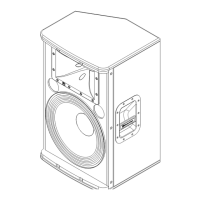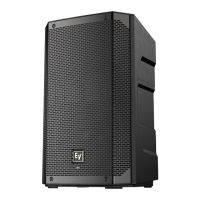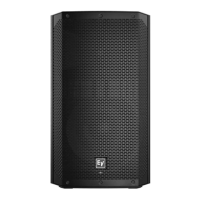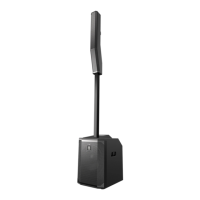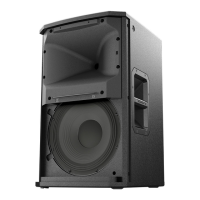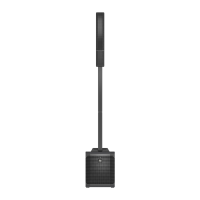Eliminator Monitor
Eliminator Monitor
2
from panel resonances.
The densely woven, industrial-grade, abuse-
resistant carpeting provides a finish that is both
attractive and highly durable. Heavy-duty cor-
ner protectors, firmly secured rubber feet, re-
cessed handles and a protective metal grille
complete the picture and ensure that the Elimi-
nator Monitor speaker system is ideally suited
to a long and reliable life on the road.
Frequency Response
The combination of a 15-inch woofer, wide-
bandwidth high-frequency driver and an equal-
ized crossover results in the wide and smooth
overall response shown in Figure 1. This re-
sponse was measured at 3.05 meters (10 feet),
using a 4-volt swept sine-wave input in an
anechoic chamber. No external equalization
was used. Figure 1 has been averaged and
corrected for 1 watt at 1 meter.
Connections
The Eliminator monitor is equipped with two
parallel 1/4-inch phone jacks. (The Elimina-
tor Monitor E version has two parallel Neutrik
Speakon
®
NL4MP connectors.) Another sys-
tem can be connected in parallel by using the
other connector. Care must be taken not to
abuse the amplifier by connecting impedances
which are too low.
Constant-Directivity Speaker System
The crossover frequency and speaker compo-
nent geometries have been selected so that the
directional characteristics of the woofer and
constant-directivity horn match at the crossover
frequency to create a special system type —
the constant-directivity system. At higher fre-
quencies the vertical coverage pattern remains
constant and the horizontal pattern smoothly tran-
sitions to a 55° angle above 5,000 Hz. Response
within the 80° x 55° rated coverage angle is uni-
form, which means dependable coverage with-
out “hot spots” or dead zones at certain fre-
quencies. The 80° x 55° dispersion character-
istic also helps avoid early reflections from
nearby surfaces which could degrade perfor-
mance. The controlled directivity of the high-
and low-frequency transducers also eliminates
response irregularities caused by diffraction off
nearby enclosure edges and, in combination
with an essentially flat on-axis frequency re-
sponse, produces a total acoustic power out-
put that is uniform with frequency.
Directivity
A unique feature of the Eliminator Monitor is
the constant-directivity dispersion provided by
the 80° x 55° horn. The polar response of the
system at selected one-third-octave bandwidths
is shown in Figure 5. These polar responses
were measured in an anechoic environment at
6.1 meters (20 feet) using one-third-octave
pink-noise inputs. The frequencies selected are
fully representative of the polar response of the
system. Beamwidth of the system utilizing the
complete one-third-octave polar data is shown
in Figure 6. Directivity factor, R
,
and directiv-
ity index, D
i
, are plotted in Figure 7.
Power-Handling Capacity
Electro-Voice components and systems are
manufactured to exacting standards, ensuring
they will hold up, not only through the most rig-
orous of power tests, but also through contin-
ued use in arduous, real-life conditions. The
EIA Loudspeaker Power Rating Full Range
(ANSI/EIA RS-426-A 1980) uses a noise
spectrum which mimics typical music and tests
the thermal and mechanical capabilities of the
components. Electro-Voice will support rel-
evant additional standards as and when they
become available. Extreme, in-house power
tests, which push the performance boundaries
of the woofers, are also performed and passed
to ensure years of trouble-free service.
Specifically, the Eliminator Monitor passes
ANSI/EIA RS-426-A 1980 with the follow-
ing values:
R
SR
= 5.10 ohms (1.15 x R
E
)
P
E(MAX)
= 300 watts
Test voltage = 39.10 volts rms,
77.33 volts peak (+6dB)
The “peak” power-handling capacity of a
woofer is determined by the peak test voltage
amount. For the Eliminator Monitor, a 77.33-
volt-peak-test voltage translates into 1,200-
watts short-term peak power-handling capac-
ity. This is the equivalent of four times the
“average” power-handling capacity, and is a
peak that can be sustained for only a few milli-
seconds. However, this sort of short duration
peak is very typical in speech and music. Pro-
vided the amplifier can reproduce the signal
accurately, without clipping, the woofer will also
perform accurately and reliably, even at these
levels.
Amplifier Power Recommendations
As noted in the Power-Handling Capacity sec-
tion, above, the Eliminator Monitor has a
random-noise power capacity of 300 watts
long-term (1,200-watts peak) per ANSI/EIA
RS-426-A 1980. The following guidelines will
help relate this to an appropriate power ampli-
fier output rating.
1. To use the Eliminator Monitor to full ca-
pacity, skilled experts in sound-system in-
stallation and operation will obtain the best
results if the power amplifier is 2.0 to 4.0
times the long-term average noise power
rating of the speaker system. For the Elimi-
nator Monitor this is 600 to 1,200 watts.
The caution cannot be made strongly
enough, however, that this arrangement is
only for experts or those who can discipline
themselves against “pushing” the system
for ever-higher sound levels and who can
avoid “accidents” such as catastrophic
feedback or dropped microphones.
2. A more conservative, “normal” amplifier
size, which will produce audible results
nearly equal to those of the “expert” rec-
ommendation, is 1.0 to 1.4 times the long-
term average noise power rating of the
speaker. For the Eliminator Monitor this
is 300 to 450 watts.
3. To be very conservative, one can use an
amplifier rated at 0.5 to 0.7 times the long-
term average noise power rating of the
loudspeaker. For the Eliminator Monitor
this is 125 to 175 watts.
Request P.A. Bible Addition No. Two
(“Power-Handling Capacity”) for more back-
ground on these recommendations.
Service
In the unlikely event the Eliminator Monitor
requires service, the woofer and driver can
both be replaced or serviced from the front. A
service data sheet is available from Electro-Voice.
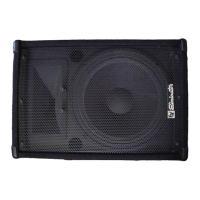
